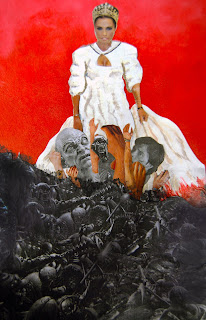Non –Objective Painting
For this assignment we were asked to create a silkscreen print, playing cards, a silhouette or a non objective painting. After much deliberation and failed attempts I chose to create a non-objective painting. To start off this piece we were asked to take photographs and research architecture as well as shapes, lines, textures and characteristics of buildings, which we would then use to base our non-objective painting off of.
This is my piece, I used acrylic paint on canvas and the subject matter was inspired by a picture of a house that I edited in Photoshop. The original picture was of the back of a house, with two windows and a bench; however, the photo itself had a huge lens flare in the middle from the sun. I then used the lens flare as the focal point of the piece after a bit of manipulation in Photoshop. In doing so I created a visually pleasing composition as well as piece that was inspired purely off form and shape rather than imagery.
During the creation of this piece i found it extremely difficult to detach myself from the imagery and focus mainly on the shapes and forms , rather than the subject matter itself. I also found it challenging to make nothing look interesting. It took a lot of thumbnailing, and various edits in Photoshop, but I managed to overcome these artistic problems and created a piece, which I think, looks really interesting, seeing how it is a painting of nothing. If i could do it again however, i would reduce the amount of emphasis i put on the lens flare and focus more on the architectural elements of the two buildings. I feel the piece would have been more visually appealing if they were more structured elements to it rather than the free flowing lines that the majority of the painting is comprised of.
Overall I am extremely pleased with the final outcome and recommend that everyone try at least one non-objective painting in their lifetime. It taught me that the subject matter isn’t always the most important thing about a painting and that one mustn’t always draw inspiration from what they see but rather what they feel.















 I chose this cropping because it had an interesting composition (DIAGONAL).
I chose this cropping because it had an interesting composition (DIAGONAL).
